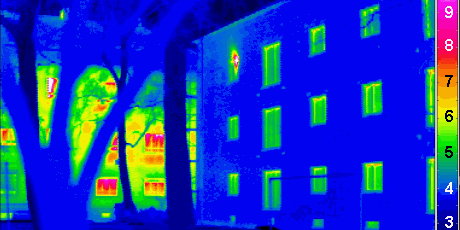What if you could slash your home’s utility bill in half and live more comfortably than ever before?
Why the Passive House Standard is a boon for the climate—and for homeowners.
BY ROBERT HAW
If the three little pigs were living in California, their brick house wouldn’t cut it. Sure, the Big Bad Wolf wouldn’t be able to blow it down, but what about earthquakes? Or the wildfire smoke leaking in? And the sky-high utility bills?
No, what that porky trio really needs is a fourth option—a home built according to the Passive House Standard. Passive Houses (PH) are designed and built in ways that are energy-efficient, draft-free, and smoke-tight, in order to deliver comfort, fresh air, and major energy-use savings.
Affordable comfort
Passive Houses don’t look all that different from other houses at a casual glance. But, viewed with infrared (heat) cameras, they stand out! Legacy dwellings show up red (lots of escaping heat) while the Passive House is blue (very little energy-waste).
Thick, well-insulated walls (and no chimney) means that Passive Houses stay at a comfortable temperature year-round (warm in the winter and cool in the summer). Those thick walls also greatly reduce outside noise. And, because they’re built smoke-tight and have filtered ventilation, the interior air quality is always excellent. That’s a real boon in a state where wildfires are all too common.
Passive Houses are resilient: if the power goes out then the house retains its cool (or heat) longer than code-minimum houses. It also means that backup systems can be down-sized.
The Passive House standard is affordable. While homes designed this way cost less than 5% extra to build than conventional housing, they offer significant reductions in operating and maintenance costs—including up to 50% savings in utility bills.
A Passive House does even more. Reducing energy-waste means consuming less energy overall (including plug-loads). This in turn means greenhouse emissions are reduced, helping fulfill California’s zero-carbon policy targets.
Building for the future
With California experiencing a chronic housing shortage, lots of new construction is anticipated in the next 25-years and new floor space is projected to increase by approximately 40% (both residential and commercial). This new growth will greatly increase electricity demand which is expected to triple by 2050. Along with higher demand comes higher peak-loads on the electric transmission system. This loading will place a massive strain on the entire electric grid.
All-electric PH can play a major role in saving the grid by moderating peak loads. For example, a passive house requires a heat pump that is just one third of the size needed by a code-minimum all-electric house. So, a Passive House, looked at from above, is the ultimate neighborhood energy conservation measure for reducing demand on the grid.
Capital construction costs for PH homes and small apartment blocks typically come in at about 1-5% higher than code-minimum projects (with experience, builders can bring down development costs appreciably). Projects bigger than that, though (like multi-unit residential PH blocks) are actually on par with legacy construction costs. It’s a matter of scale. And this feature opens-up a grand development opportunity for low-income housing.
Low-income, high impact
PH low-income housing brings extra amenities to the inhabitants for the same price. Think of developments built next to freeways. The PH filtered-air requirement will significantly reduce (if not eliminate) airborne particulate pollutants. The thick walls and multi-paned windows will reduce traffic noise. And the building’s efficiency brings down utility bills. Since capital costs stay about the same, rent should stay the same too. If it’s gonna be built anyways, let’s do it right the first time!
Almost 65,000 PH buildings have been built world-wide. In the US, the leading proponents are the City of Denver, Washington state, Massachusetts, New York, and Pennsylvania.
A golden opportunity for the Golden State
California’s building code has a respectable insulation requirement and it has an electrification requirement too. But both are far weaker than the Passive House Standard. Currently, if a developer wanted to create a project that met the Passive House Standard, the State of California expects them to also meet all the requirements of the legacy building code. This duplication of effort is expensive and time-consuming because each standard is unique and their respective ‘check-boxes’ don’t overlap. This disincentivizes PH construction instead of encouraging it.
There is a better way!
Climate Action California is proposing to add the Passive House Standard to Title 24, California’s building code. This could be introduced legislatively1 as an optional, Title-24-alternative, code-compliant pathway. The proposed pathway will be voluntary and apply to new construction only (residential and commercial). No financial obligation is imposed upon the State.
Visit our website to see the legislative brief with suggested language.
Climate Action California is seeking your support to get the Passive House standard inserted into California’s Title 24 building code. We believe that by embracing the Passive House Standard, we can get a whole lot closer to achieving California’s climate and housing goals.
Join our coalition by visiting our Passive House campaign webpage.
Below, you can download a one-page factsheet about the Passive House Standard. Feel free to share it!
Further reading
“Passivhaus: how to insulate your home against soaring heating bills” (The Guardian)
“The promise of passive house design” (Yale Climate Connections)
Robert Haw is the Building Decarbonization Team Lead at Climate Action California.
Although it applies to a very different context, an ask similar in nature to what we’re proposing for the Passive House Standard (i.e. the modification of an existing law), has been proposed this year (2024) by Senator Nancy Skinner with her bill, SB-1073 (“An act to add Section 10295.5.1 to the Public Contract Code, relating to public contracts”)




